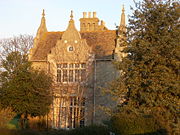
Conservators of the River Cam
Encyclopedia

Navigation authority
A navigation authority is a company or statutory body which is concerned with the management of a navigable canal or river.-Rights of a navigation authority:...
for the River Cam
River Cam
The River Cam is a tributary of the River Great Ouse in the east of England. The two rivers join to the south of Ely at Pope's Corner. The Great Ouse connects the Cam to England's canal system and to the North Sea at King's Lynn...
in Cambridgeshire
Cambridgeshire
Cambridgeshire is a county in England, bordering Lincolnshire to the north, Norfolk to the northeast, Suffolk to the east, Essex and Hertfordshire to the south, and Bedfordshire and Northamptonshire to the west...
and were founded in 1702.
History
CambridgeCambridge
The city of Cambridge is a university town and the administrative centre of the county of Cambridgeshire, England. It lies in East Anglia about north of London. Cambridge is at the heart of the high-technology centre known as Silicon Fen – a play on Silicon Valley and the fens surrounding the...
had been a major inland port as a result of its position on the navigable River Cam for centuries, but this position changed with the draining of the Fens. The most notable change was caused by the construction of Denver sluice
Denver, Norfolk
Denver is a village and civil parish in the English county of Norfolk. It is located on the River Great Ouse, 1 mile south of the small town of Downham Market, 14 miles south of the larger town of King's Lynn, and 37 miles west of the city of Norwich.The civil parish has an area of...
on the River Great Ouse
River Great Ouse
The Great Ouse is a river in the east of England. At long, it is the fourth-longest river in the United Kingdom. The river has been important for navigation, and for draining the low-lying region through which it flows. Its course has been modified several times, with the first recorded being in...
, under the terms of the Drainage Act of 1649, which resulted in tidal waters being cut off from the River Cam. Navigation became difficult, and in 1697, both the university and the town Corporation complained to parliament that the supply of goods to the town from Kings Lynn was greatly impaired.
Against this background, the Corporation sought to obtain an Act of Parliament
Act of Parliament
An Act of Parliament is a statute enacted as primary legislation by a national or sub-national parliament. In the Republic of Ireland the term Act of the Oireachtas is used, and in the United States the term Act of Congress is used.In Commonwealth countries, the term is used both in a narrow...
in 1699, which would allow them to reinstate navigation to Cambridge. The Act was obtained on 27 February 1702 and established the Conservators as a legal body with powers to collect tolls in order to maintain the river. Tolls ranged from four shillings (20p) a ton for wine to one penny (0.4p) for each passenger using the river, and the Conservators, of whom there were a maximum of eleven, were empowered to mortgage the tolls in order to raise capital with which to improve the condition of the river. This they did, and built sluices at Jesus Green, Chesterton, Baits Bite and Clayhithe. Most of the tolls were collected at Clayhithe.
Denver sluice collapsed prior to 1820, and although the Corporation of Cambridge opposed its rebuilding, it was rebuilt by 1850. Tolls on the river gradually increased, from £432 in 1752, to over £1,000 in 1803. 1835 was the best year, when tolls reached £1,995, after which they declined again, although they did not drop below £1,000 until 1847. The Conservators appear to have managed the river prudently, deriving a little extra revenue in rents from public houses which were constructed at each of the sluices.
The Cam Navigation Act of 1813 gave the Conservators powers to raise tolls and to charge penalties, while the South Level Act of 1827 extended their control over the section of river from Popes Corner to Bottisham. This Act also increased the number of Conservators by two, as the mayor and vice-chancellor of the University were appointed as official members of the body. They built locks at Baits Bite and Bottisham, and removed the sluice at Chesterton. They donated £400 towards the cost of rebuilding the Great Bridge in 1823, and a further £300 towards the cost of the small bridge in 1841. The following year they spent £880 on constructing a house at Clayhithe, which included a large room suitable for meetings and banquets.
The coming of the railways in 1845 brought to an end the success of the navigation. The Commissioners received £1,393 from tolls in 1846 but only £367 in 1850. Two further acts of parliament were obtained in 1851 and 1894, largely to alter the tolls, but receipts continued to fall, to £99 in 1898 and £79 in 1905. By this time, the lower river was managed by the South Level Commissioners, and the River Cam Commissioners again managed the river above Bottisham lock.
Responsibility for the lower river passed to the Environment Agency
Environment Agency
The Environment Agency is a British non-departmental public body of the Department for Environment, Food and Rural Affairs and an Assembly Government Sponsored Body of the Welsh Assembly Government that serves England and Wales.-Purpose:...
in 1995, but the Conservators remain as the navigation authority
Navigation authority
A navigation authority is a company or statutory body which is concerned with the management of a navigable canal or river.-Rights of a navigation authority:...
for the river above Bottisham lock. The house at Clayhithe still stands, and is now the residence of the foreman of the Conservators.

